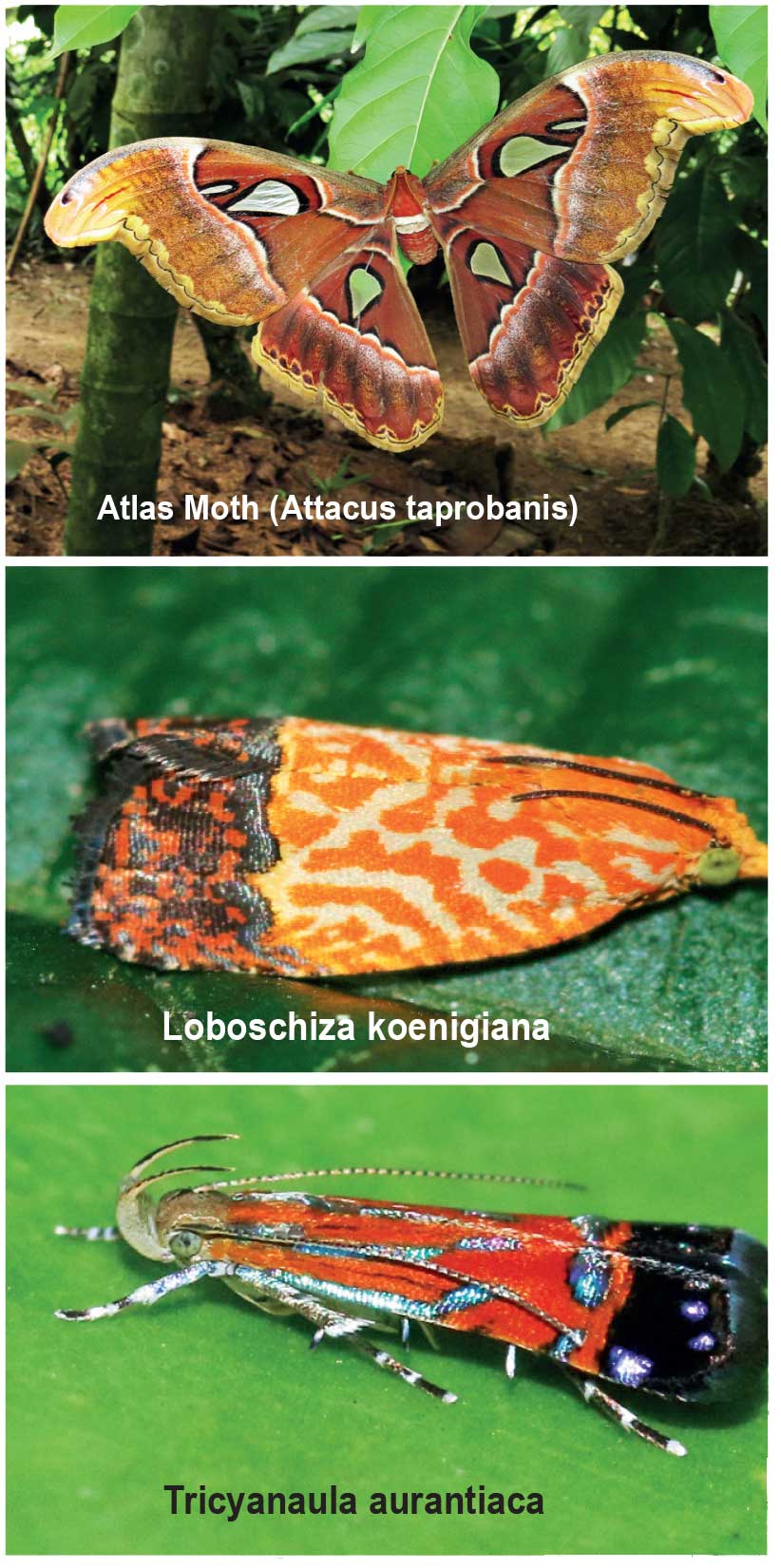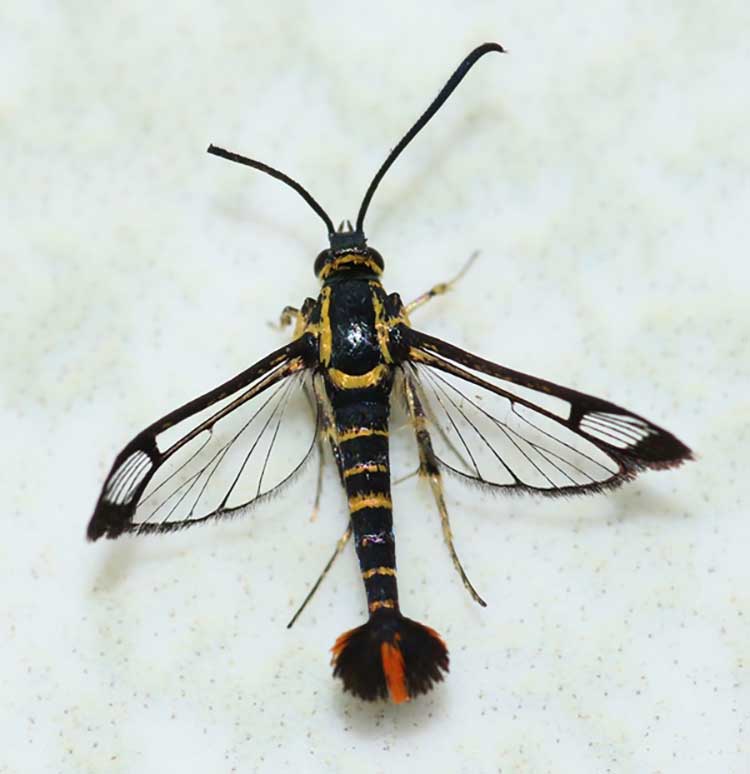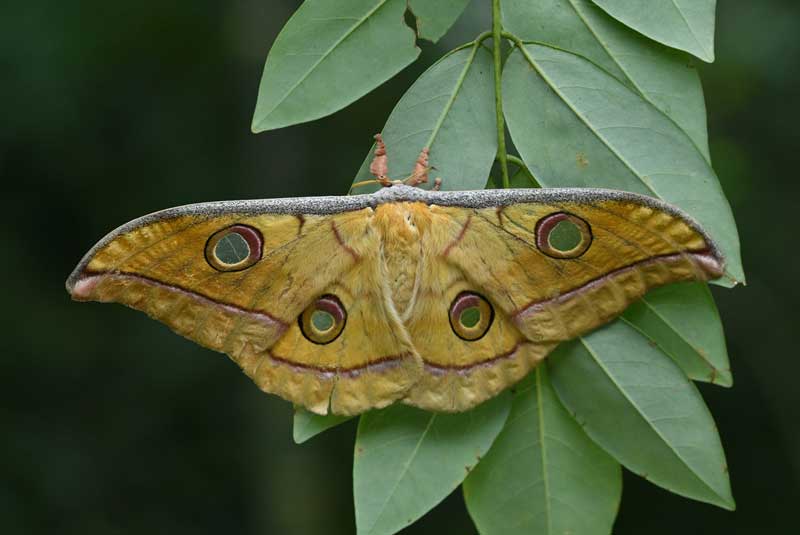Features
Hidden Marvels of Moths

Insights from Nuwan Chaturanga
By Ifham Nizam
In the world of insects, moths often remain in the shadows—both literally and figuratively. While butterflies are celebrated for their beauty and vibrancy, moths are frequently dismissed as dull or even bothersome.
Yet, as Nuwan Chaturanga, a Lepidoptera expert who is also specialising in Sri Lanka’s ecosystems, reveals, moths are far from ordinary. These nocturnal insects possess fascinating adaptations, play pivotal ecological roles, and carry cultural significance that deserves a closer look.
Masters of Adaptation
Moths have evolved into masters of survival, developing traits that enable them to navigate, evade predators, and thrive in diverse environments.
Chaturanga highlights some of the most remarkable adaptations: “Moths have developed nocturnal vision and ultrasonic hearing, allowing them to evade predators like bats effectively.” These features place moths among the most specialised creatures in the animal kingdom.
Their wing patterns offer another layer of protection, serving as camouflage or mimicry. Some moths resemble tree bark, leaves, or even other dangerous creatures to deter predators. “This evolutionary ingenuity is breathtaking,” Chaturanga says, adding that certain species, such as the owlet moth, use eyespots on their wings to mimic larger predators, startling attackers long enough to make an escape.
In addition, their erratic flight patterns make them difficult for predators to capture mid-air. These adaptations, combined with chemical defences like toxins and foul-tasting substances derived from their larval diet, make moths a marvel of evolution.
Ecological Importance in Sri Lanka
Moths are not just survivors; they are indispensable contributors to ecosystems worldwide, particularly in Sri Lanka. Chaturanga sheds light on their critical role as nocturnal pollinators.
“Moths are essential for pollinating native plants that bloom at night, such as certain orchids and fruit trees,” he explains. Unlike bees and butterflies, which dominate daytime pollination, moths ensure the reproduction of plants that rely on night-time visitors.
Beyond pollination, moths also form an integral part of the food web. Birds, bats, and small mammals rely on moths as a primary food source. Their larvae, or caterpillars, feed on plants and serve as prey for other species, maintaining a balance in the ecosystem.
However, their ecological importance is often overlooked due to misconceptions about their role. “Many people think moths are only pests, but this is far from the truth,” Chaturanga asserts. While a few species, like the rice leaf folder moth, are harmful to crops, the majority contribute positively to agriculture and natural habitats.
Myths and Misconceptions
Moths’ reputation has been marred by myths and misunderstandings, particularly in Sri Lanka. “Large black moths are often seen as harbingers of bad luck or death,” Chaturanga says. These superstitions, rooted in folklore rather than science, have contributed to their negative image.
Another widespread belief is that moths are dull and unattractive. Yet, Sri Lanka is home to many stunningly colourful moth species, some rivaling butterflies in beauty. Chaturanga highlights the Atlas Moth as an example—a species with wings spanning up to 12 inches, adorned with intricate patterns.
Additionally, while moths are often blamed for crop damage, Chaturanga clarifies that only a handful of species pose significant threats. “The fear of moths being destructive is largely exaggerated,” he notes, emphasising the need for education to dispel these misconceptions.
- Grey Swallowtail Moth (Micronia aculeata)
- Wasp-mimIc clearwing moths
The Challenges of Studying Moths
Studying moths presents unique challenges, as Chaturanga explains. “The sheer diversity of moth species makes it difficult to study them comprehensively.” With over 160,000 known species worldwide, and many more yet to be discovered, the task is daunting.
Adding to the complexity is their nocturnal behavior. “Most moths are active at night, which complicates field studies,” Chaturanga says. Researchers often rely on light traps and other nocturnal observation techniques, which are labor-intensive and logistically challenging.
Another hurdle is their small size and morphological similarity. Advanced tools like microscopes and DNA analysis are often required to identify species accurately. In Sri Lanka, the lack of local expertise and funding further hampers research efforts. “We need more trained entomologists and financial support to uncover the full scope of moth biodiversity,” Chaturanga emphasizes.
Cultural Significance Across the Globe
Moths are not just biological marvels but also cultural icons. Across the world, they are steeped in folklore and symbolism, often representing themes of transformation, mystery, and fragility.
In Sri Lanka, moths are commonly associated with superstition. “Large black moths are linked to death or bad luck, but these beliefs are purely cultural,” Chaturanga says. In contrast, Western folklore often portrays moths as harbingers of misfortune, with the death’s-head hawk moth being a notable example.
In Japan, moths are sometimes seen as symbols of fragility or decay but also hold spiritual significance, representing connections to the afterlife. Similarly, in Aztec mythology, moths were linked to fire and transformation, often featuring in rituals. These cultural interpretations highlight the profound impact moths have had on human imagination.
Threats to Survival
Moths face significant threats in the modern world, from habitat destruction to climate change. “Deforestation is destroying their natural habitats, while climate change disrupts their breeding cycles and food availability,” Chaturanga explains. These factors have led to declining populations in many regions, including Sri Lanka.
Compounding the issue is the lack of data on rare and endangered species. “We suspect that many moth species in Sri Lanka are either rare or threatened, but there’s insufficient research to confirm this,” Chaturanga laments. It’s possible that some species may have gone extinct before being scientifically described.
Bizarre and Unique Behaviours
Moths are not without their quirks. Chaturanga points to the death’s-head hawk moth, known for its ability to emit a squeaking sound when threatened. Another intriguing behavior is lachryphagy, where certain moth species drink tears from animals, a phenomenon observed in tropical regions.
These behaviors, while unusual, underscore the diversity and adaptability of moths. From mimicry to chemical defenses, their survival strategies are as varied as they are fascinating.
The Dual Role in Agriculture
Moths’ relationship with agriculture is a double-edged sword. On the positive side, they pollinate crops such as bananas and guava, contributing to food production. However, their larvae can also be destructive, with pests like the armyworm moth posing challenges for farmers.
Balancing their ecological benefits against their impact as pests requires a nuanced approach. “By understanding their life cycles and behaviors, we can manage pest species while preserving beneficial ones,” Chaturanga suggests.
- Sri Lankan Moon Moth (Actias selene taprobanis)
- Nolasena ferrifervens
A Call to Action: Preserving Moth Populations
The future of moth populations depends on collective conservation efforts. Chaturanga emphasizes simple yet impactful actions individuals can take:
Plant native flowering plants to provide food and habitat.
Reduce artificial light pollution, which disrupts moth navigation.
Avoid using pesticides that harm moths and other pollinators.
Spread awareness about the ecological importance of moths.
These steps, combined with increased research and funding, can help protect moths and the ecosystems they support.
Moths are more than just nocturnal insects fluttering in the dark. They are vital pollinators, ecological balancers, and symbols of transformation. Nuwan concludes: “Moths teach us resilience and the interconnectedness of life. It’s time we give them the recognition they deserve.”
By appreciating their beauty, understanding their roles, and addressing the challenges they face, we can ensure that these remarkable creatures continue to thrive, illuminating the night for generations to come.
Features
Ghana wants more for its cashews, but it’s a tough nut to crack
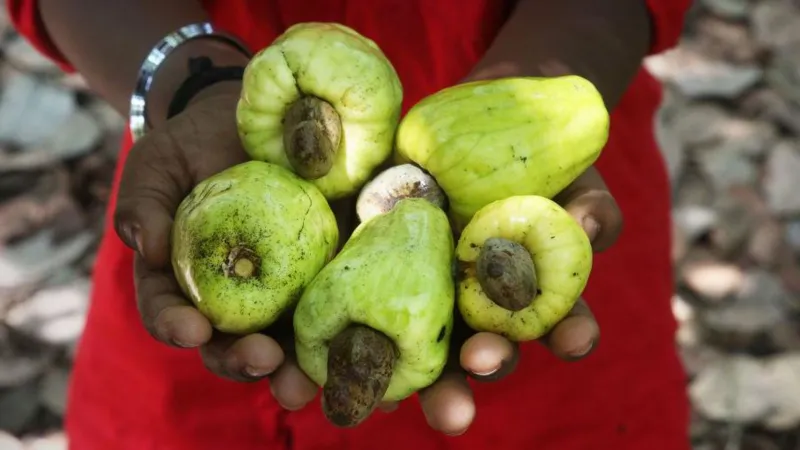
The Accra street vendor looks at me, bemused.
I’m trying to establish how the rather flimsy 30g bag of roasted cashew nuts she’s selling, beside a sweltering highway in Ghana’s capital, costs me the equivalent of about 75 cents (60p).
That’s obviously not a lot of money for me, a visitor from the UK, but I’m amazed at the mark up. The price is at least 4,000% higher than the cost of buying the same weight of raw, unshelled cashews from a Ghanian farmer. “It’s incredible,” I protest. Yet she doesn’t understand my English, or my reasoning.
The price of the nuts was, after all, printed on the packet. And explaining why I thought it was beyond the pale was never going to be easy.
Ghana is the world’s third biggest exporter of unprocessed cashew nuts, behind Ivory Coast in first place, and Cambodia in second.
To produce the crop, around 300,000 Ghanaians make at least part of their living growing cashews.
Nashiru Seydou, whose family have a farm in the country’s north-east, some 500 miles (800km) from Accra, is one of them. He says the work is hard, and unreliable supply chains and volatile wholesale prices make survival difficult. “We are struggling. We can use the sunlight, the fertile land, to create more jobs,” he says. “I’d be happy if the government comes to our aid and helps support our industry.”
He tells me that he currently gets around $50 for a large 100kg sack of unshelled cashews.
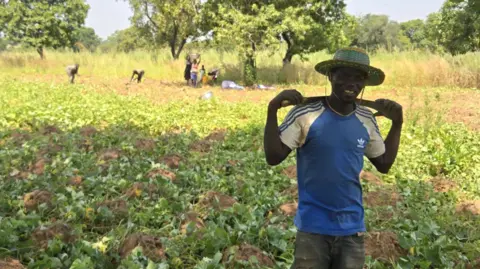
“It’s amazing,” says Bright Simons, an entrepreneur and economic commentator in Accra, who has studied the numbers. “Roasters and retailers buy the nuts from farmers for $500 a tonne, and sell to customers [both at home and abroad] for amounts between $20,000 and $40,000 a tonne.”
As a whole, Ghana grows about 180,000 tonnes of cashews annually. More than 80% is exported, and in raw, unshelled form. This generates some $300m in export revenues, but means that Ghana misses out on the significantly higher returns you get from roasted, ready-to-eat cashews.
Mildred Akotia is one person trying to increase the amount of cashews that are shelled and roasted in Ghana. She is the founder and CEO of Akwaaba Fine Foods, which currently processes just 25 tonnes a year. Ms Akotia denies any suggestion that she and others like her are price-gouging. The packaging and roasting machinery a western business would automatically use in this industry, she says, is out of reach for her because of the high cost of credit in Ghana.
“If you go to a local bank, it will cost you 30% interest to get a loan,” she complains. “As a manufacturer you tell me how large your margins are that you can afford that kind of interest? We’ve had to rely on what we can get: soft loans from relatives and grants from donor agencies.”
She says that this situation is why less than 20% of Ghana’s cashews are processed locally. The bulk are scooped up and exported to big factories in countries like India, Thailand and Vietnam.
Remarkably, some of those packaged nuts are then exported back to Ghana, where they are sold for the same price as domestically roasted cashews. This is despite the 20,000-mile sea freight round trip, and import costs.
It is a similar picture for rice, which is exported to Ghana from Asia and sold at low prices, despite Ghana also growing the crop itself.
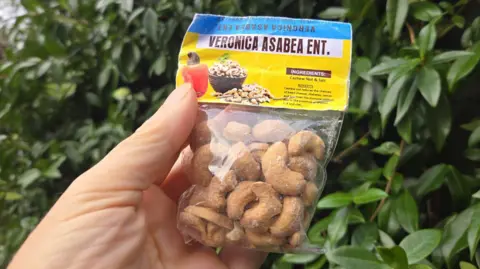
Back in 2016 the Ghanaian government experimented with an export ban on raw cashews in order to encourage homegrown processing. However the policy had to be abandoned within a couple of weeks after uproar from farmers and traders.
Without available cheap loans, it wasn’t possible for sufficient new Ghanaian roasters to enter the market. So the price of raw nuts crashed, and many started rotting for want of a buyer.
More recently there has been talk of increased tariffs on raw cashew exports and bans on exporters purchasing cashews directly from farms.
But all these policy interventions miss a key point, according to Mr Simons. A big challenge for local producers, he says, is to work harder on the basics of doing business, and growing their companies.
“In order to be efficient at this, you need scale,” he says, adding that firms need to promote eating cashews to make it more widespread in the country. “You need a lot of a Ghanaians consuming the nuts, not just a small middle class”.
Prof Daron Acemoglu, a Turkish-American economist, agrees that building a strong local market is important for Ghana’s cashew industry. He was one of last year’s winners of the Nobel Memorial Prize in Economic Sciences, for his work on the struggles facing low-income economies, and in particular their home-grown businesses.
Yet he says that the first priority should be improving access to international markets for processed Ghanaian cashews.
“These firms are dealing with workforces that aren’t properly skilled, they have infrastructures that aren’t working, they are constantly in fear of corrupt officials, or rule changes, and also it’s very difficult to reach foreign markets, he says. “They need the foreign market because the domestic market is small, and their own government has very little capacity [to boost it].”
He also wants to see the Ghanaian government improve the network of roads and railways to ease the cost of transportation.
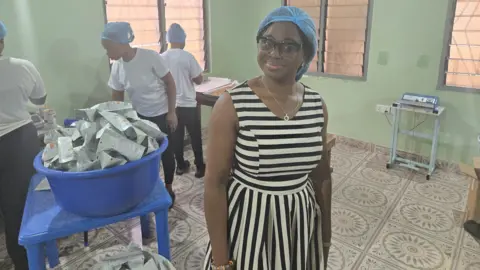
But Mr Simons reckons the onus should now be on Ghanaian businesses themselves, to do the basics to enhance the branding and marketing of cashews. As it is, he says, many of the country’s most enterprising business people are just leaving Ghana for better paid opportunities abroad because of the red tape and cronyism in Ghana are so prohibitive.
“There’s a massive brain drain,” he says. “My theory of why Africa’s economic development has been slow is because we focus too much on the supply side, but the real beauty is in demand, creating a consuming class of cashew-eating enthusiasts, and you don’t have an entrepreneurial class that can create demand transformation.”
He says the same argument applies to Ghana’s other bigger exports, like gold and chocolate, neither of which gets much value-addition within Ghana before getting exported to the West.
Mildred Akotia hopes she might be one of those entrepreneurs to buck the trend. She now wants to build her own logistics arm, to be able to process the cashews direct from the farm gate.
“I have a lot of calls from the UAE, from Canada and America. Currently we can’t meet demand. We can’t get enough kernels to roast. “There’s a ready market both locally and internationally. My branding is good, my marketing is good. My dream is to give a facelift to Ghanaian processed foods.”
[BBC]
Features
Trump’s ultra-nationalistic policies:
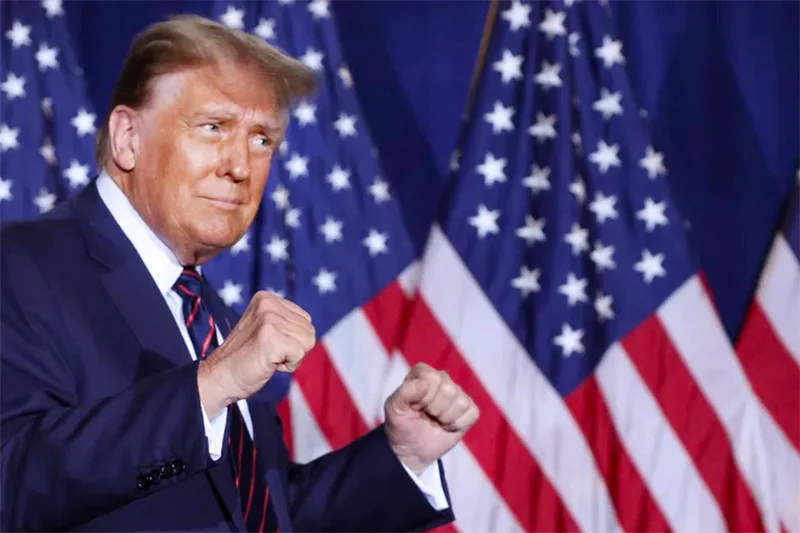
An era of ‘America First’
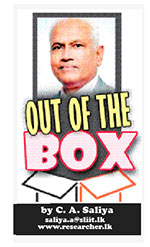 In his inaugural address, US President Donald Trump recently declared that “the golden age of America” was starting as he listed his priorities on trade, immigration, and national security. His previous presidency, which ended in 2021, left a profound mark on American domestic policies and global relations, especially through his ultra-nationalistic ‘America First’ doctrine. As he pursues re-election in 2024, the effects of his policies continue to influence both American politics and the global order, sparking ongoing debates about economic nationalism, immigration, trade, and America’s international role.
In his inaugural address, US President Donald Trump recently declared that “the golden age of America” was starting as he listed his priorities on trade, immigration, and national security. His previous presidency, which ended in 2021, left a profound mark on American domestic policies and global relations, especially through his ultra-nationalistic ‘America First’ doctrine. As he pursues re-election in 2024, the effects of his policies continue to influence both American politics and the global order, sparking ongoing debates about economic nationalism, immigration, trade, and America’s international role.
Economic Nationalism:
Protectionism and Trade Wars
A core component of Trump’s ultra-nationalistic agenda was his approach to trade, which aimed to reduce US dependence on foreign imports and rebalance trade relations. Trump’s withdrawal from the Trans-Pacific Partnership (TPP) and the renegotiation of NAFTA into the United States-Mexico-Canada Agreement (USMCA) reflected this goal. The new trade deal included provisions that favoured American workers and industries.
Trump’s trade war with China, marked by the imposition of tariffs on steel, aluminum, and Chinese goods, aimed to protect American manufacturing and address trade imbalances. However, these tariffs disrupted global supply chains and strained relationships with key allies. Critics argued that the trade measures hurt American consumers and businesses reliant on imports, while supporters saw them as necessary steps to confront unfair trade practices.
Immigration Policies: Restrictionism
and Border Security
Trump’s ultra-nationalism was also evident in his strict immigration policies, which he justified as essential for national security and cultural preservation. His administration’s “zero tolerance” policy, which resulted in family separations at the southern border, sparked widespread outrage. The US-Mexico border wall became a symbol of his presidency, with Trump arguing that it would reduce illegal immigration and drug trafficking. However, its effectiveness remained a contentious issue.
Additionally, the travel ban restricting immigration from predominantly Muslim countries was seen by opponents as discriminatory and in conflict with American ideals of diversity and inclusion.
Foreign Policy: America
as a Lone Actor
Trump’s foreign policy emphasized America’s sovereignty over international cooperation, often adopting a more isolationist stance. He frequently criticized multinational organizations, such as NATO and the United Nations, accusing them of unfairly benefiting from American contributions. Trump withdrew the US from the Paris Climate Agreement, arguing that it disadvantaged American industries, and he also pulled out of the Iran nuclear deal, opting for a more unilateral approach.
His administration’s focus on bilateral agreements over multilateral diplomacy continued his ‘America First’ stance, which sought to prioritize American interests over global cooperation.
Cultural Nationalism and
Populist Rhetoric
Trump’s rhetoric tapped into a cultural nationalism, emphasizing traditional American values and critiquing globalism. His message resonated with working-class Americans who felt left behind by globalization and demographic changes. However, his inflammatory language often exacerbated divisions within the US, particularly with minority groups.
Trump’s Legacy: Polarizing
but Persistent
Trump’s ultra-nationalistic policies were praised by supporters for their bold assertion of American sovereignty and self-reliance. Critics, however, argue that these policies eroded global cooperation and undermined America’s global leadership. Domestically, they were seen as deepening political polarization and neglecting the country’s multicultural identity.
While Trump’s previous presidency officially ended in 2021, his influence persists, especially as he seeks to reclaim the White House in 2024. The ripple effects of his policies continue to reverberate across American politics and global relations, embodying both the promises and perils of his ‘America First’ agenda.
Economic Impact
Trump’s protectionist economic policies had a complex impact. While his tariffs on imports and tax cuts aimed to boost domestic production, they also disrupted global trade and raised costs for US businesses and consumers. His tax reforms, designed to stimulate growth, contributed to higher national debt without yielding substantial wage growth or long-term investment benefits. Trump’s stance also led to a decline in foreign direct investment (FDI) as global investors faced increased uncertainty.
Impact on Trade Partners
Trump’s trade policies reshaped relationships with countries like China, Mexico, Canada, and the European Union. The trade war with China, for instance, led to reduced exports and higher consumer costs. The renegotiated USMCA imposed stricter labour and environmental standards on Canada and Mexico, altering the competitiveness of industries in both countries. Meanwhile, tariffs imposed on European products disrupted the automotive and steel industries.
Impact on Developing Countries
For developing nations, which rely heavily on trade with the US, Trump’s policies increased trade barriers and disrupted global supply chains. Countries in Asia, Africa, and Latin America faced challenges in maintaining access to the US market, which limited their economic growth potential. His withdrawal from multilateral agreements, like the TPP, further restricted trade opportunities for developing countries.
Direct Impacts on Sri Lanka
Sri Lanka, heavily dependent on exports to the US, saw the effects of Trump’s protectionist measures. Despite benefiting from tariff-free access, under the US Generalized System of Preferences (GSP), Sri Lankan exporters faced heightened uncertainty due to the renegotiation of trade agreements and the imposition of tariffs. Trump’s ‘America First’ strategy reduced demand for imports from developing countries like Sri Lanka, making it harder for industries such as textiles and apparel to thrive.
Additionally, Trump’s tax reforms, which incentivized US companies to repatriate profits, led to reduced foreign investment in Sri Lanka, particularly in sectors like tourism, manufacturing, and technology.
Indirect Impacts on Sri Lanka
The US-China trade war had a significant indirect impact on Sri Lanka’s economy, as China’s reduced access to the US market led to a decline in demand for Sri Lankan exports to Chinese industries. At the same time, the trade war disrupted global supply chains, affecting Sri Lanka’s participation in regional production networks. However, there were some positive effects, particularly in the apparel sector, where Sri Lanka briefly gained market share as American buyers sought alternatives to Chinese products.
Debt Sustainability and Dollar
Appreciation
Trump’s tax cuts and tariff measures contributed to the appreciation of the US dollar, which had adverse effects on Sri Lanka. The stronger dollar increased Sri Lanka’s dollar-denominated debt servicing costs, exacerbating fiscal deficits and limiting its ability to finance essential development projects. It also pushed up the cost of imports, leading to inflationary pressures on goods like fuel and food.
Geopolitical Implications
Trump’s reduced focus on South Asia and disengagement from multilateral organizations opened the door for China to expand its influence in the region, particularly through initiatives like the Belt and Road Initiative (BRI). Sri Lanka deepened economic ties with China, including major infrastructure projects, like the Colombo Port City and Hambantota Port, which increased Sri Lanka’s dependence on Chinese financing. Critics argue that this dependency undermines Sri Lanka’s policy autonomy.
Impact on Remittances
Sri Lanka’s reliance on remittances from overseas workers was also indirectly affected by Trump’s immigration policies. Stricter immigration restrictions and a reduced openness to foreign workers in countries like the US and the Gulf States led to fewer employment opportunities for Sri Lankan migrant workers, thereby impacting remittance inflows that are crucial to Sri Lanka’s economy.
In conclusion, Donald Trump’s ultra-nationalistic policies, which reshaped both American and global landscapes during his presidency, continue to reverberate in the 2024 election cycle. His ‘America First’ approach, while securing the support of a significant portion of the American electorate, has also sparked intense global debate over the trade-offs between national sovereignty and international cooperation. For nations like Sri Lanka, Trump’s protectionist trade measures, shifting geopolitical priorities, and tax reforms have had profound effects on exports, foreign investment, and economic stability. As Trump seeks a return to the White House, the legacy of his policies will remain a defining feature of American politics, global trade, and international relations, forcing nations to navigate the complexities of a world where economic nationalism increasingly dictates the rules of engagement.
(The writer, a senior Chartered Accountant and professional banker, is Professor at SLIIT University, Malabe. He is also the author of the “Doing Social Research and Publishing Results”, a Springer publication (Singapore), and “Samaja Gaveshakaya (in Sinhala). Views expressed in this article are personal. He can be contacted at saliya.a@slit.lk and www.researcher.com)
Features
The President’s Jaffna visit and its implications
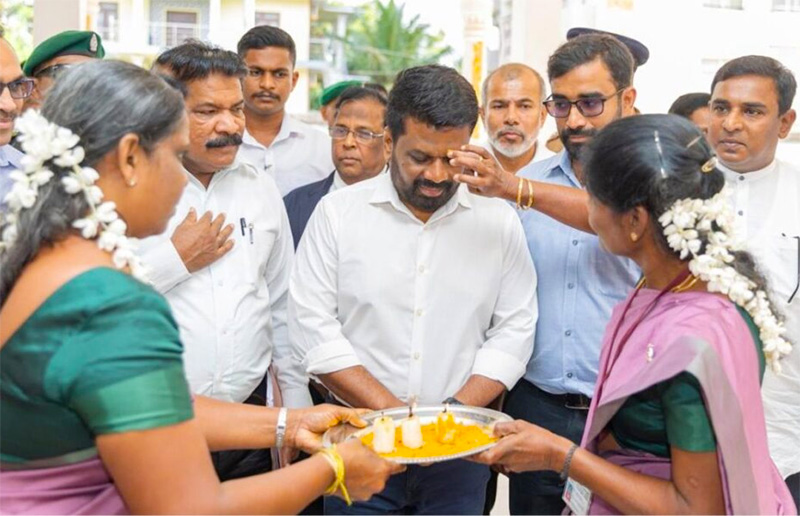
by Jehan Perera
President Anura Kumara Dissanayake is showing the change for the better that a single individual can bring by challenging old ways of doing things by those who have traditionally governed the country. According to the news media and first person accounts by reliable commentators contacted in Jaffna, the president’s visit to the Jaffna peninsula last week was a resounding success that is good for the unity of the country. It seems that the president timed his visit to the north in the context of forthcoming local government elections that are anticipated to be held in April.
The focus on Jaffna during his visit would have been the central place that Jaffna has as the civilisational seat of the Tamil people. The president used the time he had allocated to Jaffna to pay his last respects to former parliamentarian and leader of ITAK (Federal Party) who had, for decades, been at the forefront of the Tamil struggle for regional self-government, devolution of power and equal rights. He also had the confidence to go to Valvettithurai which was the birthplace of the late LTTE leader Velupillai Prabakaran and conduct a public meeting there.
The president’s visit took place without the usual high security in which large numbers of soldiers would be placed at strategic locations not only in the areas that the president would be visiting but also on the approach roads to Jaffna. Residents observed that the security presence appeared to be low in comparison to the past, when roads would be closed and security personnel stationed on a 24-hour basis on the roads in residential areas. The reduced level of security demonstrated the president’s trust in the goodwill of the people. During his visit he mingled at close quarters with the people, being embraced and having his photographs taken with them.
EVERYDAY FOCUS
Addressing the people, President Dissanayake promised to bring development to Jaffna. In the year prior to the onset of fierce fighting in Jaffna that destroyed its housing and factories, Jaffna had a handful of industries, chief amongst them being the salterns in Paranthan and the cement factory at Kankesanthurai. The president pledged to rebuild these industries and to establish three new industrial zones in Paranthan, Mankulam, and Kankesanthurai to boost employment and economic growth. Sri Lankans who emigrated due to the war were invited to invest in these projects.
The president also used the occasion of his visit to present an analysis of the reasons for the ethnic conflict the country had experienced. He said that previous generations of politicians had used ethnic nationalism as a means to win elections and this had resulted in the division of people into different communities that did not trust each other. However, the last general election that had brought the NPP to power had seen the people reject the traditional political leaders who came from elite families. Instead, they had voted for the NPP regardless of ethnicity, religion or region. The president pointed out that this was a new development.
The general election in December last year saw the NPP win the majority of parliamentary seats in the north and east which have traditionally voted for Tamil political parties which take up an ethnic Tamil nationalist line. The main issues they have canvassed have been Tamil equality and self-rule in the north and east. However, those parties have never been able to deliver on the mandates they received at elections. Some of the Tamil parties reached agreements with the ruling parties of those days, but were invariably let down. The president’s focus on the everyday problems of the people would be important in inducing them to vote for the NPP at the forthcoming local government elections.
UNHRC RESOLUTION
It is worth noting that President Dissanayake made a positive impact on the people of Jaffna even though he did not address the issues of Tamil nationalism and self-rule that have preoccupied them in the past. The fact that the forthcoming elections are local level ones also reduces the significance of national issues. Local government elections the world over are about local level issues rather than national ones. In his public speeches the president spoke about providing jobs to unemployed university graduates from the 30,000 vacancies in state institutions. He stated that Tamil speaking police officers would be recruited. He also referred to improving the water supply schemes to the people of the north, making the observation that they had the lowest consumption of piped drinking water in the country
The president would be aware that whatever concession he makes to Tamil nationalism will be seized upon by his political opponents in the south of the country to fan Sinhalese nationalism. There are indications that the former ruling parties that got defeated at the last presidential and general elections are seeking to make a comeback by coalescing with one another. Their concern about the present political developments would have been increased by the president’s statements in Jaffna that the government would not permit the self-seeking traditional political elites to divide the people anymore and that they will be held accountable before the law for corruption they have engaged in.
The president’s analysis in Jaffna that ethnic nationalism was used by rival political parties to obtain electoral support to prevail at elections is an accurate one. However, the underlying issues that the ethnic nationalist politicians utilised to come to power need to be dealt with in a way that is mutually accepted by all communities. Sri Lanka is still in a post-war situation where there is no more war. But the causes and consequences of the war still remain unresolved in the form of missing persons, long term prisoners, land that is under military occupation and the continuing high military presence in the north and east of the country.
Sri Lanka now needs to become a post-conflict society. This requires that the issues of the war that continue to unresolved be dealt with without further delay. This is what the UNHRC resolutions in Geneva that come up time and time again are about. There have been 16 IMF agreements in the past but not a single government could implement them to the end. It appears that the present government is determined to go the course to get Sri Lanka onto a sound economic footing. In the case of the ethnic conflict there have been many political solutions proposed to politically resolve the ethnic conflict. But no government has had the strength or conviction to take them forward and ensure sustainable national unity. Perhaps government led by President Dissanayake will.
-
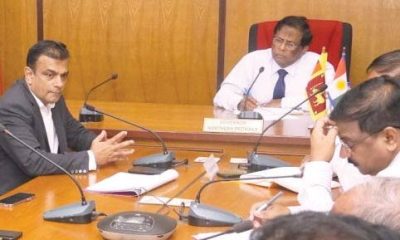
 News4 days ago
News4 days agoNew Bangalore-Jaffna flights in the works
-

 Features6 days ago
Features6 days agoA singular modern Lankan mentor – Part I
-

 Editorial7 days ago
Editorial7 days agoRegime changes and scandals
-
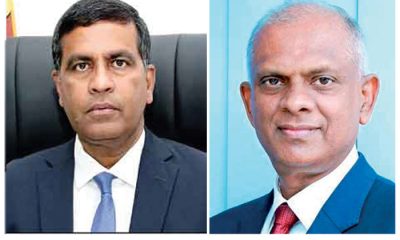
 News2 days ago
News2 days agoCID questions top official over releasing of 323 containers
-
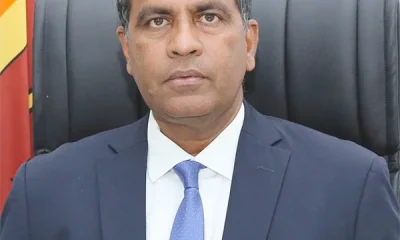
 News7 days ago
News7 days agoCustoms cleared thousands of ‘marked’ containers sans examination beginning last year
-
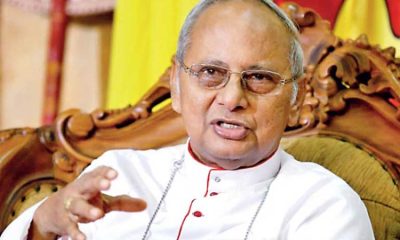
 News4 days ago
News4 days agoCardinal says ‘dark forces’ behind Easter bombs will soon be exposed
-
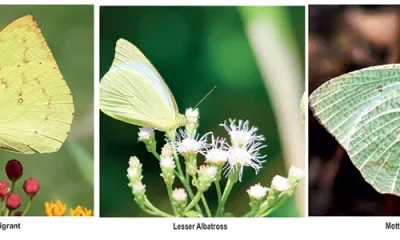
 Features7 days ago
Features7 days agoButterfly migration fading away
-
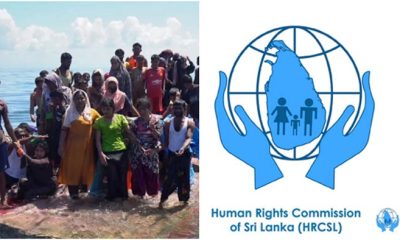
 News4 days ago
News4 days agoHRCL reports on Rohingya asylum seekers


